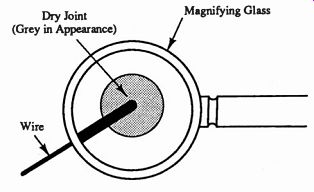The term 'dry joint', which is used frequently throughout this guide, warrants further explanation at this point.
The 'dry joint' is the most likely fault in soldering, and is the biggest single cause of failure, especially in electronics.
The main causes of the dry joint are too small a soldering iron or bit and dirty work.
What is a Dry Joint? Simply explained, a dry joint is what occurs when the soldered joint appears to be made but where, due to insufficient heat or dirty work, the solder has in fact not taken properly. The problem with a dry joint is that it appears to work, indeed it could work properly for years, but eventually fails. A dry joint is very difficult to see, as the failure point is between the solder and the work. In technical terms a dry joint is caused by oxidization between the solder and the materials being jointed. In the case of electrical joints, this causes the electricity to jump across the joint rather than flow. In time, this will cause micro sparking across the joint which will eventually fail.
It is simple to demonstrate the mechanical side of a dry joint. Find a piece of metal which is too large for your soldering iron to solder, I would suggest a piece of steel about 1 / 16 of an inch thick. Clean it thoroughly by removing all the grease and dirt. Now try to solder a wire to it by applying the soldering iron to the wire and plate and adding solder.
After a while the solder will appear to flow and also the wire will appear to stick to the plate. You should then be able to lift the plate with the wire.

Fig. 7.1 Testing for dry joint

Fig. 7.2 Magnified view of a dry joint
Now test the joint by holding the plate and pulling the wire over the joint, as shown in Figure 7.1. If the experiment has worked the wire will peel away from the plate without breaking. This will be a true dry joint. Close inspection will show the joint to be dull matt grey in colour and if viewed through a magnifying glass will show small bubbles all over the joint (Figure 7.2). These bubbles would eventually cause complete failure of the joint both electrically and mechanically. As you can see it is almost impossible to detect a dry joint with the naked eye. It is therefore very important that particular attention is paid to the recommendations given as to soldering iron size and solder types for each type of work, in order to avoid this problem.